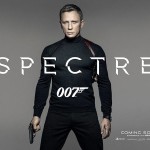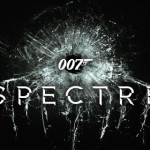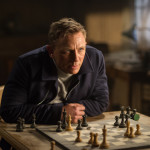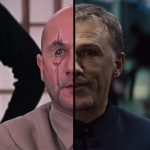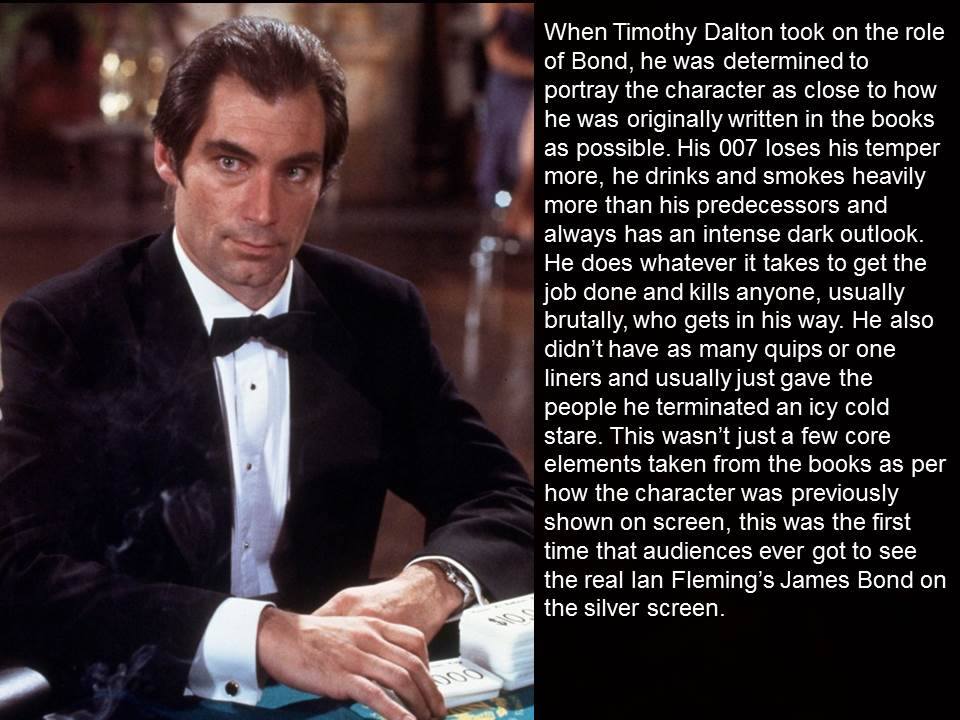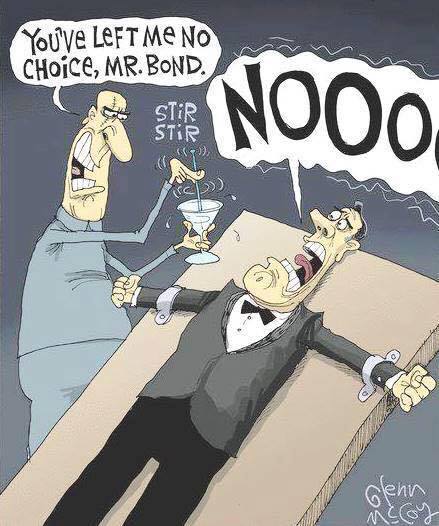From the moment my dad took me to see You Only Live Twice when I were a lad, I was hooked on Bond. The whiff of romance and adventure was sheer genius to an impressionable young boy. By and large I’ve carried on watching the franchise, but with increasing cynicism. I was not keen on SPECTRE‘s predecessor in the Bond canon, a movie known as Skyfall – though I was quite keen on Adele‘s title song. To me it seemed yet another weary reinvention of Bond, though in itself a step up from the dismal Quantum of Solace. But with Sam Mendes at the helm Bond appears to have perked up and seems destined for another set of adventures – at least for now.
What, I asked myself, is the point of Bond? What purpose does the franchise serve? 24 movies in, long beyond the original Ian Fleming oeuvre and several generations removed from the character and technologies Fleming envisaged – though no fewer than nine other writers have published books about the character, not to mention plenty of spoofs (and some say all of Roger Moore‘s Bond appearances were spoofs too), Bond keeps ticking away and attracting the punters.
So – having thought through the Bond Brand, my estimation of the essence of the movies runs thus:
- John Barry‘s funky Bond theme music, played over Bond walking across screen before turning to shoot, whence the screen is soaked blood red.
- The intro section before the main titles, usually the most thrilling section of the movie
- The movie theme song over the titles, which must be iconic in its own way
- The titles themselves, which usually hint at female nudity without being explicit
- Bond is dressed in the finest bespoke suits, and in spite of the dangers faced never looks dirty or to have a hair out of place
- In the course of a mission he will visit numerous glamorous locations
- He will almost always drive fast, luxurious cars, most of which are laden with gadgets
- He will stay in the very best luxury hotels, presumably at taxpayer’s expense
- He always drinks vodka martini, shaken not stirred
- At some point he always introduces himself as “Bond, James Bond”
- Beautiful women fall for Bond’s charms at very regular intervals, and seem unable to resist him for long – though Léa Seydoux lasts a reel or two longer before wavering
- Typically they never last for long, so he is always seeking new female companions
- Bond used to be misogynistic, eventually became fairly PC and is now wavering between the two
- Before Timothy Dalton, Bond was wont to deliver witty throwaway one-liners at regular intervals
- Up to Daniel Craig he possessed a sleek black barnet (a wig in the case of Sean Connery.) Bond is currently blond and has little discernible sense of humour.
- Bond has a licence to kill, and invariably does, sometimes with his traditional Walther PPK pistol
- The plot always consists of Bond tracking and finding middlemen to gain information, usually killing them, until he tracks down the real top villain
- Baddies are always terrible shots; Bond always kills each henchman first time
- Bond is usually captured at some point, but always wins in the end
- Everywhere he goes, Bond causes mayhem, danger and damage, yet never seems to suffer the consequences
- There are always handy gadgets, vehicles, guns or other devices whenever Bond needs them
- There is almost always a happy ending with Bond getting the girl, the exception being On Her Majesty’s Secret Service, where Bond’s only known wife is arbitrarily killed at the end.
I’m quite sure you will think of more, but you get my drift: the plot of each Bond movie is, by and large, formulaic, down to the explosions, fights, chases, gunfire, gadgets, cars, drinks and women. Yes, I know the plots are packed with holes, non-sequiturs, clichés and stereotypes. They are predictable, and they are that way because, along with cutting-edge excitement, that’s what the audience wants and expects.
Or do we?
Doubtless there have been PhD theses written on Bond, his movies and his contemporary relevance from Dr No in 1962, the start of Bond as we know him in the person of the venerable Sean Connery, to this epic in 2015. In the ensuing 53 years Bond has been played by no fewer than eight actors, culminating in Daniel Craig, here in his fourth outing. We’ve been through seven Ms, six Qs, six Miss Moneypennys, and at least nine Felix Leiters (he seems to have morphed from white to black in the process), and any number of power-crazed mega wealthy villains, and even more nubile Bond girls, ever ready to be seduced by Bond’s subtle charms and manly physique.
Two minutes googling and you will find lists comparing the movies in order to rate them from every aspect you may wish to judge (try here and here and here, among many more.) They are a commodity, each to be valued and categorised, which to me is sad.
Maybe Bond is slightly more complex and emotional than the ruthless cold-hearted assassin of yore, but I wonder what his motivation is? In the original Fleming books he was very much defending King and Country (bear in mind he was a Royal Navy Commander in the war) but in SPECTRE it gets personal, such that Bond goes off-piste and directly disobeys instructions from his superiors. He always was a touch rebellious and independent, but his heart was in the right place (dammit, here is a man who enjoys his job – wouldn’t we all love that?!) Maybe we are supposed to feel jealous of Bond, to put ourselves in his shoes, even if luxury is more attainable now than it was in the early 60s.
In practice, he would be way too much of a loose cannon to be allowed out in the field, but in the cosy world of movies the hero gets leeway. Even when licence is revoked they come out smelling of roses eventually, and so it is with SPECTRE – Bond is vindicated and the forces of good (ie. British government, though many would disagree our government is in any way beneficent) are protected for another day. We citizens are saved from evil one more time, yet we didn’t realise we were in danger! The theme of this movie seems to defend the old-fashioned type of spying, the sort popularised in fiction by the likes of Le Carré, and against intrusive global surveillance – whereby you can be spied upon anywhere and at any time. A touch ironic, maybe?
As I’ve said before, were he a real life spy, Bond would be a goner within five minutes, so he remains a glamorous ingénue with a penchant for luxury living, a man whose professional methods bear little or no relation to real life; put simply, he exists for entertainment value only – like a comic strip hero without Marvel or supernatural powers. But even Bond can’t rest on his laurels if he wants to continue his glittering screen career.
Evidently the need to make Bond ever more spectacular, exciting and dangerous is not lost on veteran producers Barbara Broccoli (daughter of Cubby) and her half-brother Michael G Wilson, since SPECTRE is, at $300m, the second costliest film ever made, after Pirates 4 (you could have made the entire Lord of the Rings trilogy for that! See the full list of priciest movies here.) While the box office will still produce a return on investment, the death of Bond may yet come as storylines become ever more elusive while inflation for delivering a Bond movie spirals inexorably upwards.
The cost inflation of Bond movies also contributed to the marketing savvy, since this launch campaign is orchestrated with consummate care and skill. As always, the movie is packed with product placements, not least the first sighting of the prototype Aston Martin DB10 (alas drowned, what a waste!), a car that has yet to hit the roads but is apparently given a trial spin by the British secret service and given a few original optional extras courtesy of Q. As in past movies, Bond wears Omega watches, who have a SPECTRE special Seamaster 300, available to you and me at a cool £4,785, should we wish to copy Bond – and doubtless some viewers will buy the watch, drive the car and wear the suit – though not necessarily fire the gun.
Of course, these days you don’t have to create all the stunts in live action, so CGI contributes greatly to the set piece spectacles, which some might argue is not the same but is infinitely better than, say, Roger Moore pretending to ski against the backdrop of pre-shot off-piste footage. CGI is now done so well you would be hard-pressed to spot where it starts and ends.
For example, in the pre-titles section of the new film, there is a jaw-dropping sequence of a building collapsing under Bond, with the character leaping from one safe haven to another as the world falls about him. Equally, effects and miniatures account for the existing MI5 building being demolished and a new building sprouting up on the banks of the Thames, in an amazing parallel reality. There is now nothing you can’t do on film, and the film-makers are cashing in on that opportunity.
However, the fight in and out of the helicopter was, presumably, real and a good old-fashioned stunt of the kind for which the Bond franchise is a world leader. Where next, you wonder? Doubtless the ideas men are dreaming up the next impossible stunts as we speak.
This is Bond’s first encounter with evil crime syndicate SPECTRE since Diamonds are Forever in 1971, though in this case SPECTRE is pretty much introduced from scratch on the assumption that modern audiences will have forgotten all about the world’s most evil criminal empire. From his film debut in From Russia With Love to his apparent demise in DAF, “Number 1” Ernst Stavro Blofeld was the epitome of evil. He has returned from the dead and in the process morphed like Doctor Who through several generations. Having started out as the gloriously camp Donald Pleasance, he progressed through a range of fine character actors, ultimately arriving in a new incarnation that looks remarkably like Christoph Waltz.
Wisely, Waltz has eschewed the Pleasance bald head and pasty complexion, though the original scar (which vanished round about the time Telly Savalas briefly became the evil one – amazing what surgery can achieve!) does make a reappearance before the end. Waltz has developed through the course of several fine movies the knack of behaving in a light and cheery manner while barely disguising a truly menacing edge. To my mind this is the first real Blofeld we’ve had since Pleasance, and more than a match for Craig in the acting stakes – but then baddies always were the best roles to play for the greatest actors.
So that’s the primary villain (though there are others, including the massive lunk that is Mr Hinx), intent as ever in world domination, not to mention revenge on Bond from childhood. What of other regular characters? Time was when most were little more than cardboard cutouts, cameos contributing little to the storylines. In the course of reinvention, the writers have a long, hard look at these core supporting characters, expanded on their back-stories and given them a more active role.
Most notable was the new-found vulnerability of Judi Dench’s M in Skyfall – maybe to offer a more human angle, She briefly returns from the dead in SPECTRE, if only to provide the loyal 007 with a rationale for heading to the Mexican Day of the Dead celebrations to cause further mayhem.
We now have a vigorous new M (Ralph Fiennes), one who is decidedly more active than Bernard Lee and other previous Ms. Also a new Moneypenny (Naomie Harris), who is no less keen on Bond than her predecessors but is not quite so intent on giving away her virtue. Q (Ben Whishaw) is infinitely younger than Desmond Llewelyn‘s quartermaster of old, and has become a computer whizz (you never knew the secret service depended on the computer hacking skills of one individual, did you?) And as a fan of Rory Kinnear, I have a sneaking admiration for the MI6 chief-of-staff, Tanner.
Essentially, the update makes for a more rounded and credible acting, to justify the hokum – though you still have to take the plots and action sequences with a pinch of salt. Is SPECTRE any less predictable?
No, frankly – though I did promise a friend I would not reveal any plot spoilers, just in case. The core ingredients are pretty much the same, the script writing (by consortium of four) is pretty reasonable, though it retains remnants of the “Goodbye Mr Bond” melodramas of the past. Perhaps it has gained a tad more subtlety and humanity over the years, but never veers far from the recipe of yore, much as if it were mother’s special chocolate cake.
This is a beautifully crafted movie. It features excellent actors doing a pretty damn good job, and the die hard fans love it to bits. If I’m going to be critical, I’m far less keen on the title song (“Writing’s on the Wall” by Sam Smith), but it can’t and doesn’t try to escape from its origins – it is a Bond movie first and last. Old fans continue to watch Bond ultimately because he is part of the furniture, and new fans are attracted by the cutting edge action. We are comfortable and familiar with him because he has a track record. We know what to expect, and that is what is delivered.
He is almost a cinematic version of a favourite sitcom, but like any favourite sitcom it can’t go on reinventing itself forever. There will come a time when Bond conducts his last mission, which will come when one or more of the following come about:
- When the film economics don’t work and the cost outweighs the return
- When the end product is boring and/or repetitive (“oh yes, I remember that – he did it in xxxx”) – Bond has to be bigger and better each time or he dies a death.
- When moviegoers get tired and move on to some other hero and/or the hard core of Bond fans die out – since many of these people are now, unlike Bond, well into middle age.
That Bond has defied the years by staying roughly mid-to-late 30s is remarkable enough, though it’s even more remarkable that he has stayed alive and barely incurred a scratch, let alone a life-threatening injury – though when he does recovery seems to take about 5 minutes. With nary a scratch on his perfectly honed and immaculately tailored body, the fantasy Bond seems ready to go on forever – or until someone chooses to kill him (good grief – surely not?!), or more likely to pension him off. I remember once the late Alan Coren wrote a brilliant send-up in Punch magazine under the title “Dr No will see you now” on the assumption that Bond is past his best and has to muster his forces for one last campaign.
No, I think Bond will go down like Dorian Gray, forever young and beautiful – and he would definitely prefer to be die “on the job” just as he did in You Only Live Twice. Boys will be boys.
PS. Friends reading this are still puzzled about whether I actually like it, so for their benefit let me say this: I admire it, I recognise its strengths, the stunts, the craft that went into making it, but can I love it? Sorry, no I can’t. It seems a hoary old character in a formulaic adventure, when what we should really be getting is unpredictability and invention from film-makers. Let’s pension Bond off now and put the $300m resources into 20 new and innovative movies!




